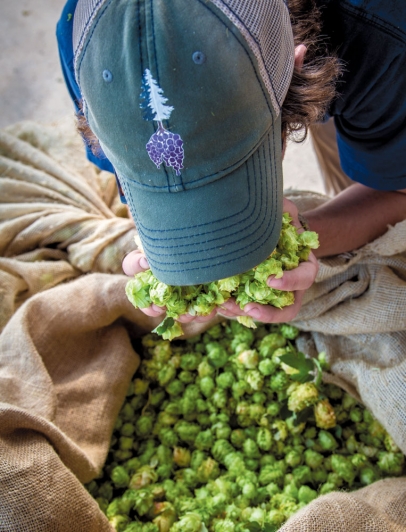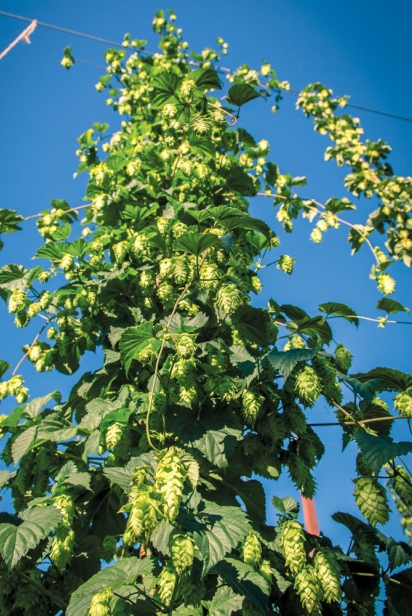The Hop Comeback
A SMALL RESURGENCE OF SONOMA’S “LOST CROP” BRINGS NEW OPPORTUNITIES FOR LOCAL CRAFT BREWERS AND FARMERS.
Hop plants are enchanting. Stout stems grow 18 feet high, circling clockwise up vertical trellises. The flowers, technically the “hops” of the hop plant, dangle lightly and bounce in the wind, delicate acorn-like cones with petals that have the texture of tissue paper, making it hard to believe that they power some of the boldest flavors of the contemporary American craft beer industry.
On the day I visit the Hawley Winery vineyards in Healdsburg’s Dry Creek Valley, there are eight rows of hop plants, thriving next to bushes of heirloom tomatoes, artichokes and olive trees. The place is buzzing with the sounds of bees, irrigation and the team from Santa Rosa’s Fogbelt Brewing Company as they orb around a ladder, one of their members snipping the bines (hop plants are categorized as bines because they grow via their shoots, while vines grow using tendrils). A few of the staff take photos with plants cascading over their shoulders and towering behind their heads like oversized flower crowns. It’s an unusual scene in Sonoma County these days, where the oncethriving hop industry collapsed in the late 1950s.
To back up, let’s take this hopportunity to explain what hops are and why they matter (first and last hop pun, I promise). The basic recipe for beer calls for just three ingredients: water, yeast and grains (usually malted barley). But that simple recipe invites infinite variations, as evidenced by the plethora of brew choices on grocery shelves and on tap in your local watering hole. This is because various kinds of plants or mixtures of herbs and spices are oft en incorporated into the mix to add flavor and depth.
Hops weren’t introduced to beer craft until some 8,000 years into its illustrious history, but their capacity for flavoring, bittering and aroma—along with their antimicrobial properties—have secured their place as the fourth essential ingredient. We mostly think of hoppy beers as bitter IPAs, but there are an array of varieties, and they can be citrusy, grassy, piney or floral.
Once a hotbed of hop production, Sonoma’s hop profile petered out after World War II, in the face of competition from Northwestern states, areas where flat land and cool climates lent themselves to advanced harvesting mechanization and large-scale farming. Today, most U.S. hop production still happens in eastern Washington and Oregon.
Hops don’t just look delicate, they are: The resin that contains the namesake flavoring is easily perishable, remaining fresh for only about 48 to 72 hours. Accordingly, most hops are dried and pelletized before delivery to breweries for storage and use throughout the year. Local sourcing has not been an important consideration.
Recently, however, a trend of making beers using fresh hops—known as “wet hop beers”—has gained traction. For brewers outside of the areas where hops are grown, it’s a logistical challenge to get fresh hops into the brewery quickly enough. So Fogbelt and a group of local farmers and other breweries are rising to it.
“I first started farming hops before we opened the brewery, back when we were home brewing,” said Paul Hawley, co-owner of Fogbelt Brewing Company. “My family grows grapes and my dad has been making wine all his life, so I’ve always been familiar with the connection between agriculture and beverage production, and to me it seemed like, ‘Why wouldn’t we grow the ingredients ourselves?’”
When Hawley first planted his quarter-acre plot four years ago it was the largest “hopyard” in Sonoma County. Small but significant, Hawley’s hopyard was the inspiration for a number of growers who are now meeting the emerging demand from local breweries. These farmers, together with a handful of local breweries, have recently formed the NorCal Hop Growers Alliance as a way to share resources, create visibility and collect data.
There are a number of advantages to a local hop resurgence, even a micro one. Farmers diversify their crops and develop a niche product, potentially supplying demand from Northern California’s 100-plus breweries. Craft brewers get to produce beers with distinctly different hop profiles. Fresh hops can be grassier and have more intense fruit aromas, adding a new layer of depth. It’s like cooking with fresh herbs rather than dried. And as an industry, farm-to-kettle presents a new hook for beer consumers who are eager to support local farmers, and to taste and talk terroir.
There are nuances to growing hops successfully, though, so one of the Alliance’s goals is to cut down on the challenges new hop farmers face. Microclimates make a big difference in terms of what varietals grow well, so what one farmer chooses to plant in Sebastopol might not work in Healdsburg. Hops also require nutrient-rich soil and a lot of water.
“Many of the growers are who are struggling to get good yields underestimate just how many nutrients and how much water they need to do well,” said Hawley.
With most of the farming expertise from Sonoma’s hop heyday lost, the Alliance is picking up the torch by crowdsourcing knowledge among themselves and bringing in outside resources. They’re also partnering with the University of California Cooperative Extension to provide ongoing research-based education, and they recently connected with a plant geneticist from UC Berkeley who is helping them start a hop breeding program, developing new hop varieties based on the wild heritage hops they’ve collected. On March 24 this year, the Alliance will host their annual Small Scale Hop Farming Seminar at Shone Farm in Forestville.
So far, efforts are paying off.
“We more than doubled our members last year and we more than doubled our acreage in the last year as well,” said Mike Stevenson, owner of Warm Springs Wind Hop Farm, and the founder of the Alliance.
This last harvest, 10 farms harvested and sold all 1,500 pounds of their wet hops to breweries.
“... without even tasting a wet hop beer, I understand the difference from a dried hop beer. Fresh hops burst with aroma.”
“Pretty much all the farmers in the area have joined [the Alliance], and now I’d like to get more breweries as members just to be supportive of it, and also so they have consistent access to fresh hops,” Stevenson said.
It is at Hawley Winery, where Hawley’s family has been growing and making wine since the 1980s, that, without even tasting a wet hop beer, I understand the difference from a dried hop beer. Fresh hops burst with aroma. Hawley shows me a Chinook, a spikey variety typically used for bittering that smells like grapefruit and pine. I catch him smelling a hop that’s gone bad and I take a whiff : It’s garlicky and sour.
After the harvest in Healdsburg, the Fog City team drives its bags of hops back to the brewery in Santa Rosa, where the Alliance’s shared hop harvester plucks the flowers from the bines, the flavorful cones headed straight into the kettle.
Hawley and his business partner, Remy Martin, say their road to brewing began out of necessity when the longtime friends took a semester abroad from UC Santa Cruz to New Zealand, working the evening shift at wineries. After getting off work it was too late to purchase beer, so they started home brewing. Later, Martin went on to UC Davis’ master brewing program, and Hawley went to work in his family vineyard. They started Fogbelt together in 2013.
The brewery now includes a busy taproom and distribution throughout Northern California. Last year they produced six different wet hop beers. To celebrate, they hosted a wet hop festival in the brewery parking lot in September, which will be repeated this coming fall. It’s full circle for Hawley, whose years of trial and error on the hopyard are finally paying off .
“My grandma grew up along Russian River, and used to pick hops for her summer job. It was big business back then,” said Hawley. “Last time I checked there were only 65 acres planted to hops in California, while in Yakima, Washington, there are something like 400,000. So yes, it’s very small scale right now, but a lot of people are interested and it’s growing.”







